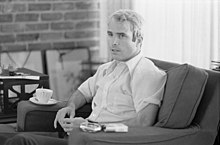United States prisoners of war during the Vietnam War
The treatment and ultimate fate of U.S. prisoners of war in Vietnam became a subject of widespread concern in the United States, and hundreds of thousands of Americans wore POW bracelets with the name and capture date of imprisoned U.S. service members.The first fighter pilot captured in North Vietnam was Navy Lieutenant (junior grade) Everett Alvarez, Jr., who was shot down on August 5, 1964, in the aftermath of the Gulf of Tonkin incident.[4] During the first six years in which U.S. prisoners of war were held in North Vietnam, many experienced long periods of solitary confinement, with senior leaders and particularly recalcitrant POWs being isolated to prevent communication.[6] Throughout the war the tap code was instrumental in maintaining prisoner morale, as well as preserving a cohesive military structure despite North Vietnamese attempts to disrupt the POW's chain of command.Although North Vietnam was a signatory of the Third Geneva Convention of 1949,[9] which demanded "decent and humane treatment" of prisoners of war, severe torture methods were employed, such as waterboarding, strappado (known as "the ropes" to POWs),[10] irons, beatings, and prolonged solitary confinement.[11][14] During one such event in 1966, then-Commander Jeremiah Denton, a captured Navy pilot, was forced to appear at a televised press conference, where he famously blinked the word "T-O-R-T-U-R-E" with his eyes in Morse code, confirming to U.S. intelligence that U.S. prisoners of war were being harshly treated.The march soon deteriorated into near riot conditions, with North Vietnamese civilians beating the POWs along the 2 miles (3.2 km) route and their guards largely unable to restrain the attacks.On November 21, 1970, U.S. Special Forces launched Operation Ivory Coast in an attempt to rescue 61 POWs believed to be held at the Sơn Tây prison camp 23 miles (37 km) west of Hanoi.[25] Nevertheless, by 1971, some 30–50 percent of the POWs had become disillusioned about the war, both because of the apparent lack of military progress and what they heard of the growing anti-war movement in the U.S. and some of them were less reluctant to make propaganda statements for the North Vietnamese.Although its explosions lit the night sky and shook the walls of the camp, scaring some of the newer POWs,[30] most saw it as a forceful measure to compel North Vietnam to finally come to terms.In the 2000s, the Vietnamese government has held the position that claims that prisoners were tortured during the war are fabricated, but that Vietnam wants to move past the issue as part of establishing better relations with the U.S.[36] Bùi Tín, a North Vietnamese Army colonel-later turned dissident and exile, who believed that the cause behind the war had been just but that the country's political system had lost its way after reunification,[37] maintained in 2000 that no torture had occurred in the POW camps.[38] Tin stated that there were "a few physical hits like a slap across the face, or threats, in order to obtain the specific confessions," and that the worst that especially resistant prisoners such as Stockdale and Jeremiah Denton encountered was being confined to small cells.Indeed, a considerable literature emerged from released POWs after repatriation, depicting Hoa Lo and the other prisons as places where such atrocities as murder; beatings; broken bones, teeth and eardrums; dislocated limbs; starvation; serving of food contaminated with human and animal feces; and medical neglect of infections and tropical disease occurred.







United States armed forcesprisoners of warVietnam WarWorld War IIKorean WarDoug HegdahlNorth VietnamPeople's Army of VietnamViệt CộngHỏa Lò PrisonPOW braceletsOperation HomecomingVietnam War POW/MIA issueQuảng TrịL-19/O-1 Bird DogCaptainFloyd James ThompsonLieutenant (junior grade)Everett Alvarez, Jr.Gulf of Tonkin incidentOperation Rolling ThunderLyndon JohnsonRichard NixonOperation LinebackerOperation Linebacker IIRobinson RisnerJames StockdaleAlcatraz Gangtap codeLieutenantLieutenant CommanderRobert ShumakerThird Geneva Convention of 1949waterboardingstrappadoCommanderJeremiah DentonHanoi MarchJohn McCainJohn A. DramesisuicideCode of the U.S. Fighting ForceJohnson administrationNixon administrationU.S. Secretary of DefenseMelvin LairdHo Chi MinhNational League of Families of American Prisoners and Missing in Southeast AsiaJames N. RoweOperation Ivory CoastSơn Tây prison campgrowing anti-war movement in the U.S.the resumed bombing of North Vietnam starting in April 1972"Christmas Bombing" campaignB-52 StratofortressSam JohnsonMedal of HonorberiberiFrench IndochinaPotemkin villageJohn L. BorlingCharles G. BoydAir Force CrossRalph T. BrowningSilver StarPhillip N. ButlerFred V. CherryGeorge CokerNavy CrossDonald CookBud DayJohn P. FlynnJohn W. Frederick, Jr.Larry GuarinoJames H. KaslerRichard P. KeirnJoe KernanJoseph KittingerCharles KlusmannWilliam P. LawrenceJames LewisHayden LockhartJohn McCain IIIU.S. SenatorPete PetersonJon A. ReynoldsJames Robinson RisnerRobert H. ShumakerLance SijanRoss Perot's 1992 Presidential campaignOrson SwindleFloyd ThompsonLeo K. ThorsnessHumbert Roque VersaceParis Peace Accordswar crimesGeneva ConventionBùi TínAndersonville National Historic Sitemedical neglecttropical diseaseFaith of My FathersHollywoodThe Hanoi HiltonStuart RochesterBrace, Ernest C.St. Martin's PressReader's Digest PressMcCain, JohnSalter, MarkRandom HouseRochester, Stuart I.Naval Institute PressTouchstone BooksKarnow, StanleyAmerican ExperienceAir Force News ServiceAir Force MagazineThe New York Times MagazineU.S. News & World ReportThorsness, LeoThe Philadelphia InquirerThe Boston GlobeRoberts, Steven V.The New York TimesUSA Today